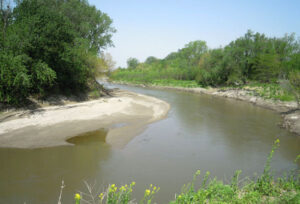
Mormon Wagon Train.
Central City, Kansas, in Nemaha County, was laid out in 1855 by William Dodge for Thomas Newton and his sons and H. H. Lanham. It was located in Section 1, Township 2, Range 12, about two miles southeast of Baker’s Ford. Other early settlers included the Eli Williams family, who settled about two miles to the east in 1855.
In August 1855, a party of Mormons en route to Utah wintered about seven miles northeast of Seneca before the settlement of Kansas Territory. Their reported campsite was at Murphy Lake, about two miles southeast of Baker’s Ford, near the mouth of Deer Creek. Driven by hunger, the Mormons drained the lake to catch and eat the fish. Many became ill, and about 40 died. They were buried nearby, their graves marked with boulders that were used in a barn foundation some years later.
The Central City Baptist Church was organized on August 1, 1857, with Elder T. Newton and his wife, Reverend Thomas Newton and his wife, and H. H. Lanham and his wife as charter members. The members built a small church structure, also used as a schoolhouse afterward. Thomas Newton’s son, J. L. Newton, was a freighter from Atchison, Kansas, to Fort Kearny, Nebraska, in the 1860s.
Central City’s post office, which opened on June 15, 1858, was the first in the county. The first postmaster was H. H. Lanham, who also operated a blacksmith and wagon shop and a horse-power sawmill and grist mill, all owned by the Newton and Lanham families.
There was also a store kept by Benjamin Shaffer that was later sold to Beeler & Williams of Iowa Centre but was managed by and in the name of Lanham and Newton. The mill was bought in Kansas City, brought to its destination by teams, and ran for a time by ox-power. In 1857 or 1858, its proprietors built a dam across the Nemaha River. However, failing to secure sufficient power to run both business branches, they put in a vertical boiler and a small engine, using the water power for the millstones and steam power for sawing.
During the high water of 1858 and 1859, when Nemaha River was a mile in width, the dam and grist-mill works were carried away. What remained of the establishment was moved to the prairie and leased to Leslie & Barnbrick, who put in a bolt and other necessary machinery, and for a short time, ran a saw, grist, and flour mill. Later, it was destroyed by an incendiary fire, rebuilt, sold, and moved away.
The first school in Central City was taught by Mahlon Pugh in 1859
In 1863, Lanham & Newton bought a steam mill in Pawnee City, Nebraska, bringing it to Central City and removing it to Seneca a few months later.
Central City’s post office closed on August 14, 1863. Primarily a settlement of pro-slavery settlers, Central City lost favor when Kansas Territory began moving toward making it a Free-State.
On September 12, 1875, the Central City Baptist Church formally united with the Seneca Baptist church.
The town was never incorporated. Later, the townsite became a farm.
©Kathy Alexander/Legends of Kansas, updated November 2024.
Also See:
Extinct Towns of Nemaha County
Sources:
Blackmar, Frank W.; Kansas: A Cyclopedia of State History, Vol I; Standard Publishing Company, Chicago, IL 1912.
Cutler, William G; History of Kansas; A. T. Andreas, Chicago, IL, 1883.
Kansas Heritage

